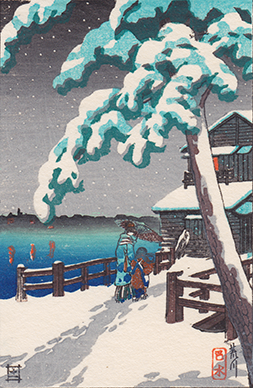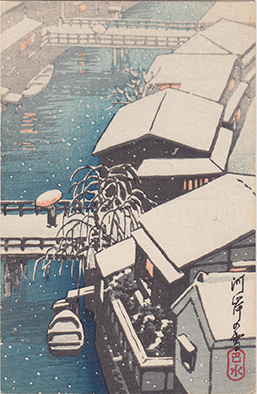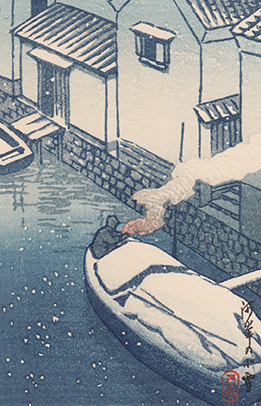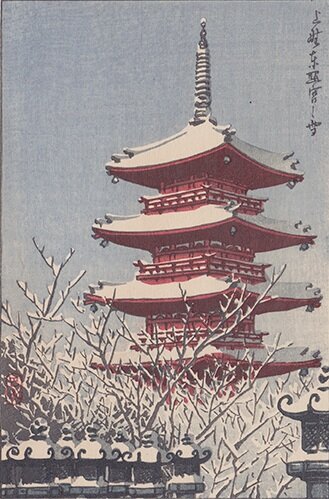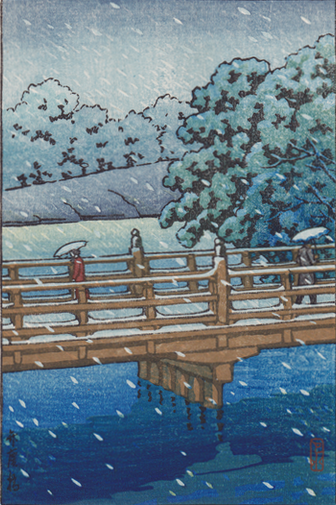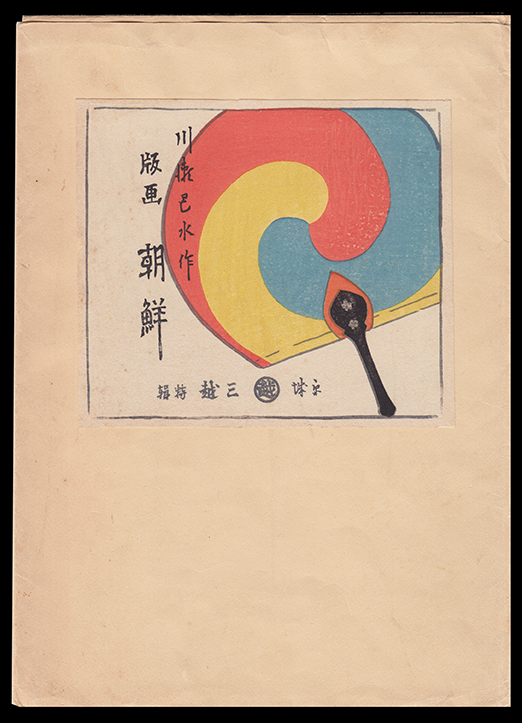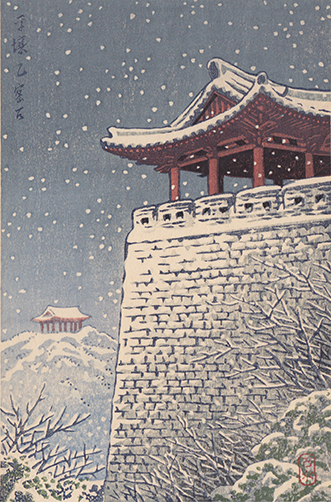Gallery 3E: Kawase Hasui
Kawase Hasui (1883-1957) is one of the most recognized artists of the Shin Hanga (new prints) movement and is known for his woodblock printed landscapes. He worked for 40 years with Watanabe Shozaburo, the publisher who is often credited with launching the Shin Hanga movement. Hasui learned western style painting before studying under the woodblock artist Kaburagi Kiyokata. In 1956, Hasui was named a Living National Treasure in Japan. Hasui produced multiple designs for small prints. He also designed small format woodblock prints for a number of books and folios. Additional Hasui designs for first day covers can be viewed in Gallery 10.
All prints in this gallery were published by Watanabe unless otherwise indicated. Titles are derived from the Watanabe 1936 catalogue when possible or from titles that have been assigned to the prints by museums, scholars, collectors or dealers. Several prints in the collection remain attached to greeting cards, postcard backs, or presentation cards, common formats for miniature prints.
Duplicate prints are presented to demonstrate differences in printing and/or presentation. Small print designs have been known to be carved side by side resulting in minor differences in lines. Worn blocks may have been recarved for later editions. The application of color with the production of sequential prints also results in subtle, and sometimes significant, variation in color. In addition, exposure to light and storage conditions can also result in fading, toning. or other effects that have influenced the current appearance of a print.
Rain in Ikaruga. 1930s-1950s. (Note: This design was also reprinted in 2017 by Mokuhankan. Carved by Kawasaki; printing by Ayumi Ōhash). 8.4 x 13.2 cm
Kenchō-ji in the Rain. 9.4 x 14.3 cm
Crescent Moon at River Tama. 1950s. 8.4 x 13.1 cm
Tsurugaoka Hachiman Shrine (Kamakura). Undated. 9.4 x 14.3 cm
Matsushima. 1930s. 14.2 x 9.2 cm
Byodoin. c.1950-1960 (original design 1930s). 13.3 x 8.5 cm
Sangatsu Hall in Nara. 1930s. 13.3 x 8.5 cm
Tsurugaoka Hachiman Shrine (Kamakura). 1930s.
Evening at Miyajima. Undated. 8.4 x 13.2 cm
Kenchō-ji in the Rain. Woodblock Printed Postcard. Undated (after 1945). 9.0 x 13.8 cm
Snow Scenery at Kinkaku-ji. 1930s. 9.4 x 14.3 cm
Snow on the Arakawa River. 1930s. 9.4 x 14.4 cm
King’s Tower, Yokohama. (Kanagawa Prefectural Government Office). 9.6 x 14.2 cm
Sacred Bridge at Nikko, 1930s. 9.2 x 14.4 cm
Sacred Bridge at Nikko, Woodblock printed postcard. 9.0 x 14.2 cm
Konjikido in Hiraizumi. Unsealed and modified version from a printing process set (See Gallery 1). Later edition from recarved blocks by an unidentified publisher. Examples with the Hasui attribution on the mounting paper exist. It has also been documented with a Hasui seal. 8.6 x 13.3 cm
Mt. Fuji from Misaka. Second copy. Undated. 9.4 x 14.5 cm
The print on the left and in the center below are the original design and are affixed to cardboard bakings typical for Hasui prints published by Watanabe in the 1930s. The print to the right is a later print from a different set of blocks which duplicates the general design but with many subtle variations. The print is also somewhat smaller than the original design. The smaller print is usually considered “after Hasui” but still printed by Watanabe. This example includes the Hasui seal in the lower left corner which is absent on other copies.
Hasui was commissioned to create several images for the covers of the magazine The Japan Trade Monthly. The design for the December 1950 issue featured Santa strolling through a snow blanketed garden and pavilion. The image appears to have been the inspiration for this woodblock print of Santa with a pagoda and temple in the background which was attached to a blank card. Two similar postcard sized images of Santa are known to exist, one with a background of a waterwheel and Mt. Fuji, and another depicting Ukimido Shrine. They may have been sold as a set of Christmas cards. This design significantly departs from the vast majority of Hasui’s work in regard to its simplicity, commercialism, and kitschy style. These images are rarely encountered. It is possible that they proved to be less popular for purchase than the more idealistic snow scenes that Hasui designed for Christmas cards. They may have also been less likely to be preserved following the Christmas season.
The prints below are miniaturizations of 5 of 6 images from the series Scenery of the Mountain Villa Kennan in Moto-Hakone. The series was commissioned by the Iwasaki family and published by Watanabe Shozaburo in 1935. These smaller images were likely printed around the same time.
Cherry Blossoms in Ueno Park, Tokyo. 11.7 x 17.8 cm
Dancing Girls Enjoying Cool Breeze on River Kamo. From Sights of Old Capital. 1919. 11.0 x 17.8 cm
Mt. Fuji with Cherry Trees. Undated. 11.6 x 17.7 cm
Lake Shōji. 1930s. 11.7 x 17.7 cm
Autumn at Shiobara. Undated. 11.3 x 17.5 cm
Pagoda in Snow at Tō-ji. 1930s. 11.6 x 17.6 cm
Ushiku Marsh. 11.5 x 17.7 cm
Heian Shrine. Posthumous, Undated. 17.5 x 11.4 cm
Okada, Ōshima. 1930s. ProvenanceRobert O. Muller. 17.6 x 11.6 cm
The two prints below are from proof sheets for the May-June and July-August pages for a 1952 Calendar. Watanabe may have published the calendar for the Pacific Transport company. These would have presumably been printed in 1951.
Sarusawa Pond in Nara. 17.6 x 11.8 cm
Three examples of a print that was inserted in the August, 1924 edition of Fujin Gurafu (Ladies Graphic) Magazine. The spot within the moon of the upper print is not intentional and represents a small stain. All three copies have some minor registration issues. For example, the sail in the middle image includes some overlap of the trees in the background. Note the visible wood grain in all of these examples which is typical of an early woodblock printing before the woodgrain fills in with ink from multiple printings. Woodblock prints in Fujin Gurafu followed the typical print production method except that the pressing of the print onto the woodblock was done using a mechanical press rather than rubbing with a baren.
The New Best Eight Scenery of Japan
The images below are from New Best Eight Scenery of Japan, an album of eight postcard sized prints tipped onto titled cards, which was published by Bijuisusha in 1927 in the same year that the images were also printed in oban size (25 x 38 cm) format in the series Collection of Ukiyo-e Designs. The prints were reproduced in 1974 by the Ukiyoe Hanga Publishing Society in the chuban size (19 x 25 cm) format.
Mt. Unzen in Hizen Province. 12.1 x 8.0 cm
Muroto Peninsula, Tosa. 12.1 x 8.1 cm
Towada Lake. 7.9 x 12.1 cm
Kamikōchi Table Land. 8.0 x 12.2 cm. This represents a miniaturized and somewhat cropped version of Taishô Pond at Kamikôchi whicdh was also published in 1927.
This set of three views of Korea was published and distributed by Mitsukoshi Department Store, most likely in 1939 or 1940 following Hasui’s travel to that country in 1939. The prints were originally affixed to presentation paper boards, although had had already been removed prior to their addition to this collection. The image of Ulmil Pavilion was recently republished by Ukiyo-e Gallery in 2018 and 2019 in three variations 1) blue sky, 2) gray sky, and 3) sepia.
Envelope for the Set
Shinto and Its Architecture
The twelve Hasui images in this section are woodblock prints that were originally designed for and tipped into the 1936 book Shinto and Its Architecture by Akiyama Aisaburō (Published by Tokyo News Service). The book and prints were republished in 1955 using the original blocks. The collection includes both the original 1936 edition, the 1955 edition, and a second set from the latter edition that was salvaged from a copy with significant adverse conditions that threatened the integrity of the prints. Prints from the first edition are distinguished by additional text in the left margin (see clickthroughs) with the exception of the print of Hachiman Shrine which is without text in both editions (but differs in impression of the lower left keyblock). The 1955 reprints lack text in the margins except for Ryobu Torii of Itsukushima Shrine. However, the title of the first edition of that print was printed in green, whereas the title is printed in black in the second edition. Side by side comparisons (1936 left; 1955 right) of two of these prints with full margins can be viewed here and here. Comparison of the prints reveal strong consistency in color palette and printing quality with very minor notable differences such as bokashi shading in the sky and some apparent block wear in the roof in the print of Yasukuni shrine.
Dear Strolling Along Kasuga Shrine. Frist edition. 1936. 12.3 x 17.4 cm
Hachiman Shrine, Kamakura. First edition. 1936. 11.3 x 17.4 cm
Hachiman Shrine, Kamakura. Second edition. 1955. 11.6 x 17.6 cm
Hachiman Shrine, Kamakura. Second edition. Second copy. 1955. 11.6 x 17.6 cm
Hie Shrine, Tokyo. After a Shower. First edition. 1936. 11.2 x 17.4 cm
Hie Shrine, Tokyo. After a Shower. Second edition. 1955. 11.4 x 17.6 cm
Hie Shrine, Tokyo. After a Shower. Second edition. Second copy. 1955. 11.4 x 17.5 cm
Heian Shrine, Kyoto. First edition. 1936. 11.4 x 17.4 cm
Heian Shrine, Kyoto. Second edition. 1955. 11.5 x 17.6 cm
Heian Shrine, Kyoto. Second edition. Second copy. 1955. 11.4 x 17.5 cm
Minatogawa Shrine, Kobe. First edition. 1936. 11.4 x 17.4 cm
Minatogawa Shrine, Kobe. Second edition. 1955. 11.6 x 17.6 cm
Minatogawa Shrine, Kobe. Second edition. Second copy. 1955. 11.5 x 17.7 cm
Kamedo Shrine, Tokyo and its Wisteria Blossoms. First edition. 1936. 11.3 x 17.4 cm
Kamedo Shrine, Tokyo and its Wisteria Blossoms. Second edition. 1955. 11.4 x 17.6 cm
Kamedo Shrine, Tokyo and its Wisteria Blossoms. Second edition. Second copy. 1955. 11.4 x 17.6 cm
Meiji Shrine, Tokyo. First edition. 1936. 11.3 x 17.3 cm
Meiji Shrine, Tokyo. Second edition. 1955. 11.5 x 17.4 cm
Meiji Shrine, Tokyo. Second edition. Second copy. 1955. 11.6 x 17.4 cm
Yasaka Shrine, Kyoto. First edition. 1936. 11.4 x 17.5 cm
Yasaka Shrine, Kyoto. Second edition. 1955. 11.4 x 17.5 cm
Yasaka Shrine, Kyoto. Second edition. Second copy. 1955. 11.4 x 17.5 cm
Ryobu Torii of Itsukushima Shrine in Inland Sea. First edition. 1936. 11.3 x 17.5 cm
Ryobu Torii of Itsukushima Shrine in Inland Sea. Second edition. 1955. 11.5 x 17.6 cm
Ryobu Torii of Itsukushima Shrine in Inland Sea. Second edition. Second copy. 1955. 11.6 x 17.6 cm
Yasukuni Shrine, Tokyo and Its Cherry Blossoms. First edition. 1936. 11.3 x 17.4 cm
Yasukuni Shrine, Tokyo and Its Cherry Blossoms. Second edition. 1955. 11.6 x 17.6 cm
Yasukuni Shrine, Tokyo and Its Cherry Blossoms. Second edition. Second copy. 1955. 11.6 x 17.6 cm
Sacred Mount Fuji. First edition. 1936. 11.2 x 17.4 cm
Sacred Mount Fuji. Second edition. 1955. 11.4 x 17.6 cm
Sacred Mount Fuji. Second edition. Second copy. 1955. 11.5 x 17.6 cm
The Wedded Rocks of Futamigaura. First edition. 1936. 11.4 x 17.6 cm
The Wedded Rocks of Futamigaura. Second edition. 1955. 11.6 x 17.8 cm
The Wedded Rocks of Futamigaura. Second edition. Second copy. 1955. 11.6 x 17.8 cm
Lantern Series
Hasui designed these lantern prints for the publisher Watanabe. Images from the 1936 Watanabe catalogue suggest that the lanterns were to be cut out. A lantern “handle” would then be added at the top to allow for hanging; a small calendar would be suspended from below. Subtle blind printing of horizontal lantern ribs added an additional three-dimensional aspect to the lantern. The intended function of these prints explains the lack of printed handles, the lack of defined borders and margins, and the somewhat off-center position of the lantern when viewing the uncropped image). The numbers associated with each prints refer to their item number in the 1936 catalogue. Print names (which are more descriptions than titles), are also taken directly from the catalogue. This set appears to be from the 1930s.
Korean Postcard Set (titles not fully translated). A set of five postcards of locations in Korea published by Watanabe in 1939 for the Mitsukoshi Department Store.
Ukiyo-e Kai Magazine Covers
Hasui produced images for the covers of several magazines. One of these, Ukiyo-e Kai (The World of Ukiyo-e), reproduced the same image over multiple issues while varying the color combinations. The latter issues were also smaller is size, with the print cropped to eliminate some of the image including the Hasui artist’s seal. The magazine was published by Ukiyo-e Doukoukai (Ukiyo-e Association) in Tokyo, produced by the National Diet Library, and edited by Narazaki Muneshige.
Prints in the Style of Kawase Hasui
A print in the style of Hasui with similarities to other village scenes by the artist. The print is without seal or signature and is occasionally accredited to the artist. Others have considered it as a print by an unidentified artist which was likely designed after a Hasui print. Copies of this print appeared in print packets by the publisher Watanabe which were distributed to guests of the Pigeon Bus Company. Further research is required to determine whether Hasui actually designed this image.
A print in the style of Hasui without seal or signature that is occasionally accredited to the artist. Further research is required to whether Hasui designed this image. This image is also know to exist as printed on silk.
This image has been attributed to Hasui. It was published by Watanabe and is stylistically similar to many Hasui designs. The print is unsealed and unsigned. A variation of the design by Seki Kenji also exists.
This image is similar in syle to Hasui and other Shin Hanga artists and has been suggested to be by Hasui. The left image in printed on paper and was included in sets of prints that were given to guests on tours of the Pigeon Bus Company. The image on the right is a rare example of the same print having been printed on silk. Both were published by Watanabe. Although the silk image had been considered to have been printed in the 1930s, the lack of other examples until the 1950s suggests that they both likely date to this later period. Note the variation in color of the woman’s kimono and the more purplish pigments in the image printed on silk.
This image has been occasionally attributed to Hasui. Although the style is consistent with many of the artist’s smaller works, it lacks any of the typical Hasui seals. The work is undated but likely post-WWII. It was published by Watanabe.
These two prints are unsigned and unsealed images published by Watanabe. The design is considered by some to have likely been designed by Hasui. Although Hasui created several small pagoda print images (see examples from the collection above), this image differs substantially from any of the known images with a Hasui seal.
This is an uncut sheet of two identical images of the image immediately above. These are unusual as they were printed on silk affixed to paper by the publisher Watanabe.
Although similar to the sealed copy of Zojoji Temple in the collection above, this print demonstrates several differences and is usually considered a plagiarized version of the Hasui original. Unsealed. Unsigned.
This image has a similar composition to the sealed Hasui print in the collection above. Close examination reveals several differences such as the composition of the mountains and people and the closeness of the temple. This unsigned and unsealed print is usually considered to be a plagiarism of Hasui’s original design.
This print has similarities to the Hasui signed Village in Snow above. However, it differs significantly in regards to the angle of the pathway in the foreground and the addition of a human figure approaching the house. Th print is unsigned and unsealed and thought to be an adaptation of the original Hasui design. The print was published by Watanabe.
A print published by Watanabe without seal or signature. The image is similar to the sealed print of Chusenji by Hasui in the collection illustrated above but has modifications such as the presentation of the boat, the more elaborate tree, and the addition of a sign to the left of the torii gate. Copies of this print have been reported to have been observed with the Hasui seal.
These two prints of the Golden Pavilion are quite similar to the image by Hasui illustrated above. The print on the left has the publisher seal of Takemura Hideo; there is no artist signature or seal.
The print on the right has a similar composition, but the angle of the pavilion, the trees in the background, the script, and the depiction of the snow covered branches in the foreground are significantly different. It also is unsigned and unsealed. This version was printed by the publisher Watanabe. Copies with the Hasui seal have been reported to exist.
The composition of this print is very similar to the print referred to as City in the Rain by Hasui. Compared to the Hasui Print (see the two examples in the collection above), this print varies in several aspects including the appearance of the women’s heads that are otherwise obscured under umbrellas, the stance of the figure in the background, which woman is holding the flowers, and other details. The print bares the Tomoe seal and was published by Watanabe. Although Tomoe has been speculated by some as actually being Hasui, many other images with the Tomoe seal instead share similarities to works by Takehashi Shotei. The most common theory is that Tomoe was a publisher’s house name and represented works adapted from designs by both Hasui and Shotei.
This print also seems to be an adaptation of City in the Rain. It again features a street scene but in a mirror image composition. Once again there are two women with unbrellas and a distant pedestrian, although this time he is walking towards rather than away from the women.
This image appears to be undocumented. It was printed on thin paper affixed to a blank card which reportedly dated to the 1920s, although this dating is questionable. It came with a set of prints with similar blank cards, all unsealed and undated but clearly reproductions of full or cropped images by identifiable artists such as Takahashi Shotei, Asano Takeji, Nagata Shunsui, and Fukuda Toyoshirō. The scene and style is similar to several prints by Kawase Hasui and could possibly represent a knock-off of a yet to be discovered Hasui design.




























































































